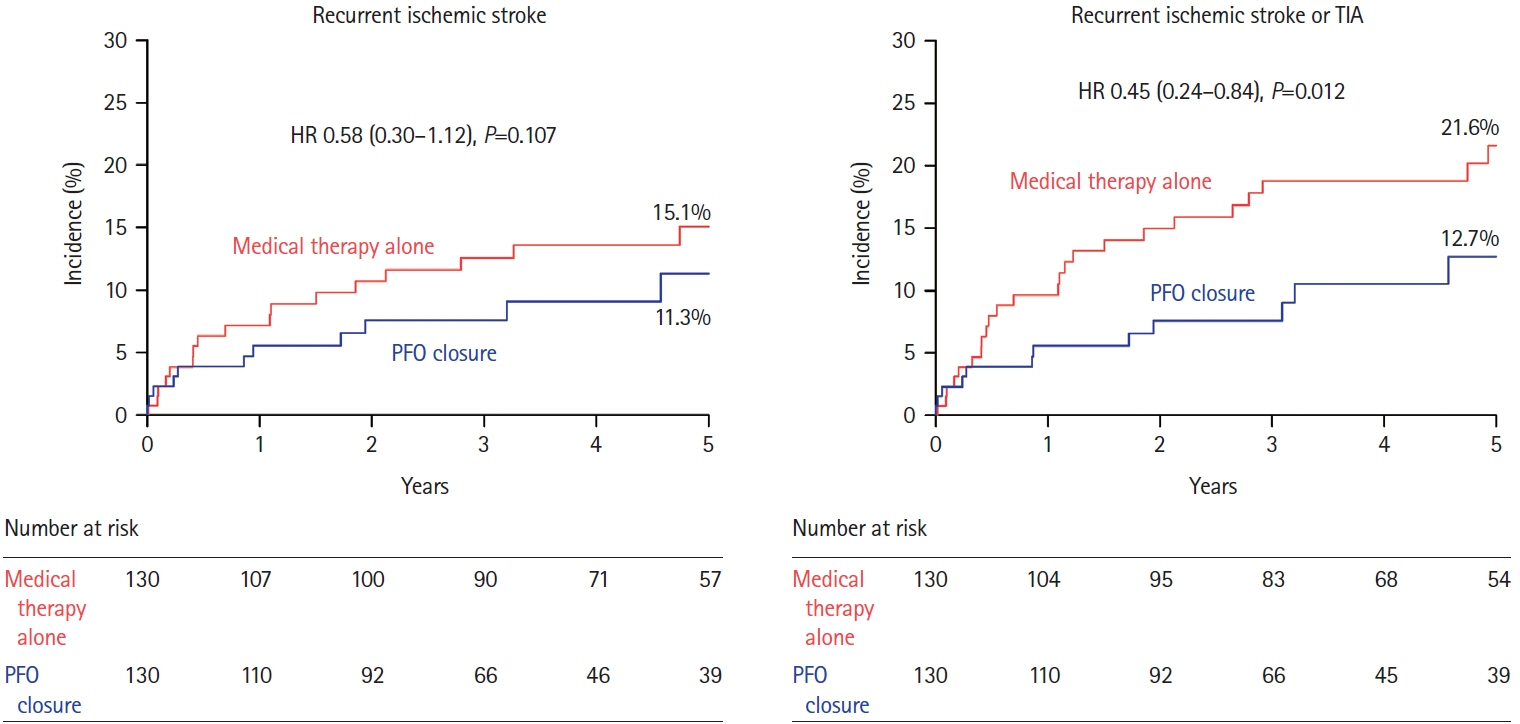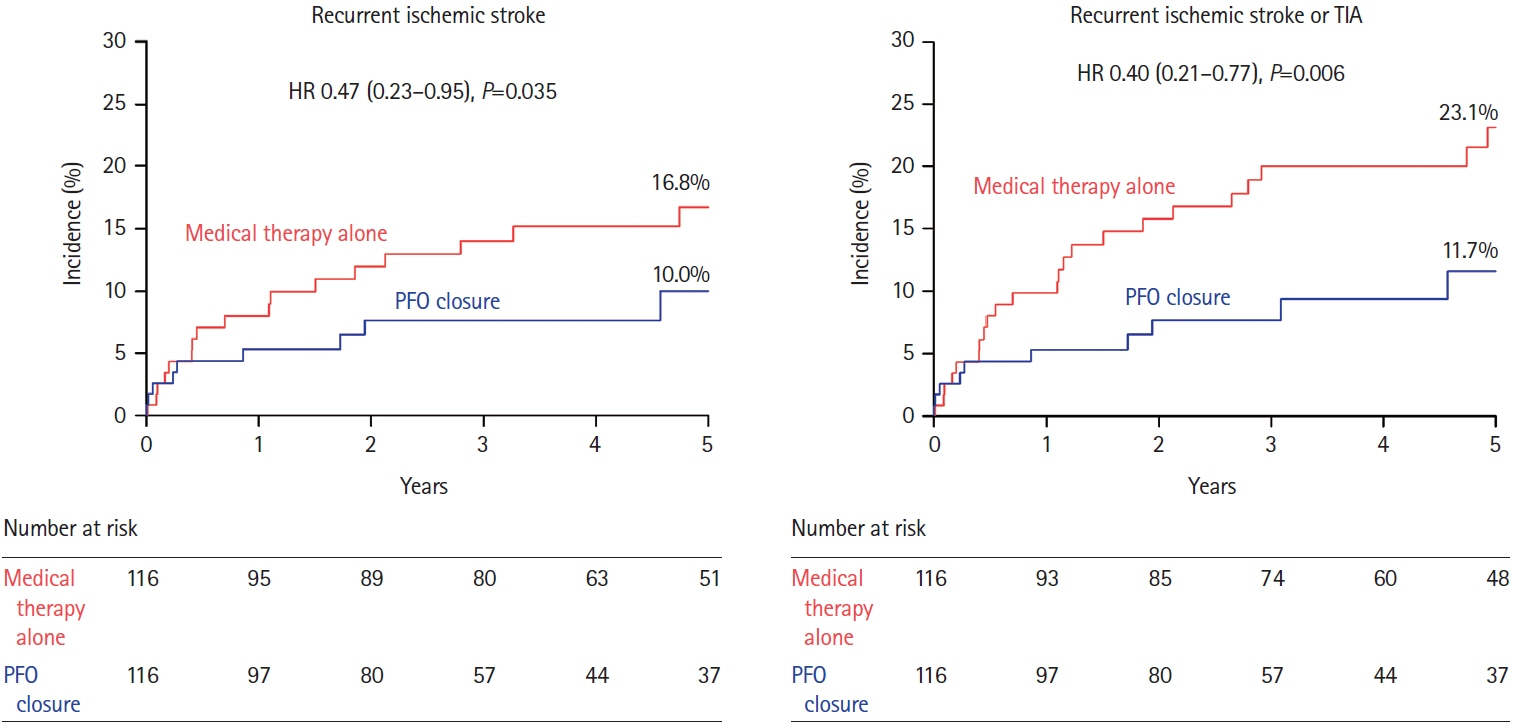J Stroke.
2024 May;26(2):242-251. 10.5853/jos.2023.03265.
Device Closure or Antithrombotic Therapy After Cryptogenic Stroke in Elderly Patients With a High-Risk Patent Foramen Ovale
- Affiliations
-
- 1Department of Cardiology, Asan Medical Center, University of Ulsan College of Medicine, Seoul, Korea
- 2Division of Cardiology, Severance Hospital, Yonsei University College of Medicine, Seoul, Korea
- 3Department of Neurology, Asan Medical Center, University of Ulsan College of Medicine, Seoul, Korea
- 4Clinical Research Center, Asan Institute for Life Science, Asan Medical Center, University of Ulsan College of Medicine, Seoul, Korea
- 5Division of Cardiology, Department of Internal Medicine, Chungnam National University Hospital, Chungnam National University School of Medicine, Daejeon, Korea
- 6Division of Cardiology, Department of Internal Medicine, Kyung Hee University Hospital, Kyung Hee University, Seoul, Korea
- 7Department of Cardiology, Ulsan University Hospital, University of Ulsan College of Medicine, Ulsan, Korea
- 8Department of Internal Medicine, Seoul National University Bundang Hospital, Seoul National University College of Medicine, Seongnam, Korea
- 9Department of Neurology, Cerebrovascular Center, Seoul National University Bundang Hospital, Seongnam, Korea
- 10Department of Cardiology, Daejeon St. Mary’s Hospital, College of Medicine, The Catholic University of Korea, Daejeon, Korea
- 11Division of Cardiology, Department of Internal Medicine, Chung-Ang University College of Medicine, Chung-Ang University Gwangmyeong Hospital, Gwangmyeong, Korea
- 12Division of Cardiology, Hanyang University Medical Center, College of Medicine, Hanyang University, Seoul, Korea
- 13Department of Neurology, College of Medicine, Hanyang University, Seoul, Korea
- 14Department of Internal Medicine, Gyeongsang National University School of Medicine, Gyeongsang National University Changwon Hospital, Changwon, Korea
- 15Regional Cardiovascular Disease Center, Chungbuk National University Hospital, Chungbuk National University College of Medicine, Cheongju, Korea
- 16Integrative Research Center for Cerebrovascular and Cardiovascular Diseases, Department of Neurology, Yonsei University College of Medicine, Seoul, Korea
- 17Department of Neurology, Kyung Hee University Hospital, Seoul, Korea
- 18Department of Neurology, Gangneung Asan Hospital, University of Ulsan College of Medicine, Gangneung, Korea
- KMID: 2556044
- DOI: http://doi.org/10.5853/jos.2023.03265
Abstract
- Background and Purpose
In young patients (aged 18–60 years) with patent foramen ovale (PFO)- associated stroke, percutaneous closure has been found to be useful for preventing recurrent ischemic stroke or transient ischemic attack (TIA). However, it remains unknown whether PFO closure is also beneficial in older patients.
Methods
Patients aged ≥60 years who had a cryptogenic stroke and PFO from ten hospitals in South Korea were included. The effect of PFO closure plus medical therapy over medical therapy alone was assessed by a propensity-score matching method in the overall cohort and in those with a high-risk PFO, characterized by the presence of an atrial septal aneurysm or a large shunt.
Results
Out of the 437 patients (mean age, 68.1), 303 (69%) had a high-risk PFO and 161 (37%) patients underwent PFO closure. Over a median follow-up of 3.9 years, recurrent ischemic stroke or TIA developed in 64 (14.6%) patients. In the propensity score-matched cohort of the overall patients (130 pairs), PFO closure was associated with a significantly lower risk of a composite of ischemic stroke or TIA (hazard ratio [HR]: 0.45; 95% confidence interval [CI]: 0.24–0.84; P=0.012), but not for ischemic stroke. In a subgroup analysis of confined to the high-risk PFO patients (116 pairs), PFO closure was associated with significantly lower risks of both the composite of ischemic stroke or TIA (HR: 0.40; 95% CI: 0.21–0.77; P=0.006) and ischemic stroke (HR: 0.47; 95% CI: 0.23–0.95; P=0.035).
Conclusion
Elderly patients with cryptogenic stroke and PFO have a high recurrence rate of ischemic stroke or TIA, which may be significantly reduced by device closure.
Keyword
Figure
Reference
-
References
1. Lechat P, Mas JL, Lascault G, Loron P, Theard M, Klimczac M, et al. Prevalence of patent foramen ovale in patients with stroke. N Engl J Med. 1988; 318:1148–1152.
Article2. Webster MW, Chancellor AM, Smith HJ, Swift DL, Sharpe DN, Bass NM, et al. Patent foramen ovale in young stroke patients. Lancet. 1988; 2:11–12.
Article3. Carroll JD, Saver JL, Thaler DE, Smalling RW, Berry S, MacDonald LA, et al. Closure of patent foramen ovale versus medical therapy after cryptogenic stroke. N Engl J Med. 2013; 368:1092–1100.4. Furlan AJ, Reisman M, Massaro J, Mauri L, Adams H, Albers GW, et al. Closure or medical therapy for cryptogenic stroke with patent foramen ovale. N Engl J Med. 2012; 366:991–999.
Article5. Mas JL, Derumeaux G, Guillon B, Massardier E, Hosseini H, Mechtouff L, et al. Patent foramen ovale closure or anticoagulation vs. antiplatelets after stroke. N Engl J Med. 2017; 377:1011–1021.
Article6. Meier B, Kalesan B, Mattle HP, Khattab AA, Hildick-Smith D, Dudek D, et al. Percutaneous closure of patent foramen ovale in cryptogenic embolism. N Engl J Med. 2013; 368:1083–1091.
Article7. Saver JL, Carroll JD, Thaler DE, Smalling RW, MacDonald LA, Marks DS, et al. Long-term outcomes of patent foramen ovale closure or medical therapy after stroke. N Engl J Med. 2017; 377:1022–1032.
Article8. Søndergaard L, Kasner SE, Rhodes JF, Andersen G, Iversen HK, Nielsen-Kudsk JE, et al. Patent foramen ovale closure or antiplatelet therapy for cryptogenic stroke. N Engl J Med. 2017; 377:1033–1042.9. Lee PH, Song JK, Kim JS, Heo R, Lee S, Kim DH, et al. Cryptogenic stroke and high-risk patent foramen ovale: the DEFENSE-PFO trial. J Am Coll Cardiol. 2018; 71:2335–2342.10. Kleindorfer DO, Towfighi A, Chaturvedi S, Cockroft KM, Gutierrez J, Lombardi-Hill D, et al. 2021 guideline for the prevention of stroke in patients with stroke and transient ischemic attack: a guideline from the American Heart Association/American Stroke Association. Stroke. 2021; 52:e364–e467.
Article11. Messé SR, Gronseth GS, Kent DM, Kizer JR, Homma S, Rosterman L, et al. Practice advisory update summary: patent foramen ovale and secondary stroke prevention: report of the guideline subcommittee of the American Academy of Neurology. Neurology. 2020; 94:876–885.
Article12. Pristipino C, Sievert H, D’Ascenzo F, Louis Mas J, Meier B, Scacciatella P, et al. European position paper on the management of patients with patent foramen ovale. General approach and left circulation thromboembolism. Eur Heart J. 2019; 40:3182–3195.
Article13. Kent DM, Saver JL, Kasner SE, Nelson J, Carroll JD, Chatellier G, et al. Heterogeneity of treatment effects in an analysis of pooled individual patient data from randomized trials of device closure of patent foramen ovale after stroke. JAMA. 2021; 326:2277–2286.
Article14. Overell JR, Bone I, Lees KR. Interatrial septal abnormalities and stroke: a meta-analysis of case-control studies. Neurology. 2000; 55:1172–1179.15. Kim JS, Thijs V, Yudi M, Toyoda K, Shiozawa M, Zening J, et al. Establishment of the heart and brain team for patent foramen ovale closure in stroke patients: an expert opinion. J Stroke. 2022; 24:345–351.
Article16. Mehran R, Rao SV, Bhatt DL, Gibson CM, Caixeta A, Eikelboom J, et al. Standardized bleeding definitions for cardiovascular clinical trials: a consensus report from the bleeding academic research consortium. Circulation. 2011; 123:2736–2747.
Article17. Hagen PT, Scholz DG, Edwards WD. Incidence and size of patent foramen ovale during the first 10 decades of life: an autopsy study of 965 normal hearts. Mayo Clin Proc. 1984; 59:17–20.
Article18. Handke M, Harloff A, Olschewski M, Hetzel A, Geibel A. Patent foramen ovale and cryptogenic stroke in older patients. N Engl J Med. 2007; 357:2262–2268.19. Mazzucco S, Li L, Binney L, Rothwell PM; Oxford Vascular Study Phenotyped Cohort. Prevalence of patent foramen ovale in cryptogenic transient ischaemic attack and non-disabling stroke at older ages: a population-based study, systematic review, and meta-analysis. Lancet Neurol. 2018; 17:609–617.
Article20. Brown RD, Whisnant JP, Sicks JD, O’Fallon WM, Wiebers DO. Stroke incidence, prevalence, and survival: secular trends in Rochester, Minnesota, through 1989. Stroke. 1996; 27:373–380.21. Marinigh R, Lip GY, Fiotti N, Giansante C, Lane DA. Age as a risk factor for stroke in atrial fibrillation patients: implications for thromboprophylaxis. J Am Coll Cardiol. 2010; 56:827–837.22. Wolf PA, D’Agostino RB, O’Neal MA, Sytkowski P, Kase CS, Belanger AJ, et al. Secular trends in stroke incidence and mortality. The Framingham study. Stroke. 1992; 23:1551–1555.
Article23. Ntaios G, Lip GYH, Vemmos K, Koroboki E, Manios E, Vemmou A, et al. Age- and sex-specific analysis of patients with embolic stroke of undetermined source. Neurology. 2017; 89:532–539.
Article24. Mazzucco S, Li L, Rothwell PM. Prognosis of cryptogenic stroke with patent foramen ovale at older ages and implications for trials: a population-based study and systematic review. JAMA Neurol. 2020; 77:1279–1287.
Article25. Diener HC, Sacco RL, Easton JD, Granger CB, Bernstein RA, Uchiyama S, et al. Dabigatran for prevention of stroke after embolic stroke of undetermined source. N Engl J Med. 2019; 380:1906–1917.
Article26. Kasner SE, Swaminathan B, Lavados P, Sharma M, Muir K, Veltkamp R, et al. Rivaroxaban or aspirin for patent foramen ovale and embolic stroke of undetermined source: a prespecified subgroup analysis from the NAVIGATE ESUS trial. Lancet Neurol. 2018; 17:1053–1060.27. Elgendy AY, Saver JL, Amin Z, Boudoulas KD, Carroll JD, Elgendy IY, et al. Proposal for updated nomenclature and classification of potential causative mechanism in patent foramen ovale-associated stroke. JAMA Neurol. 2020; 77:878–886.
Article28. Alperi A, Guedeney P, Horlick E, Nombela-Franco L, Freixa X, Pascual I, et al. Transcatheter closure of patent foramen ovale in older patients with cryptogenic thromboembolic events. Circ Cardiovasc Interv. 2022; 15:e011652.29. Kwon H, Lee PH, Song JK, Kwon SU, Kang DW, Kim JS. Patent foramen ovale closure in old stroke patients: a subgroup analysis of the DEFENSE-PFO trial. J Stroke. 2021; 23:289–292.
Article30. Merkler AE, Gialdini G, Yaghi S, Okin PM, Iadecola C, Navi BB, et al. Safety outcomes after percutaneous transcatheter closure of patent foramen ovale. Stroke. 2017; 48:3073–3077.
Article31. Tsivgoulis G, Triantafyllou S, Palaiodimou L, Grory BM, Deftereos S, Köhrmann M, et al. Prolonged cardiac monitoring and stroke recurrence: a meta-analysis. Neurology. 2022; 98:e1942–e1952.
- Full Text Links
- Actions
-
Cited
- CITED
-
- Close
- Share
- Similar articles
-
- Patent Foramen Ovale and Cryptogenic Stroke
- Transcatheter Closure of Patent Foramen Ovale in a Stroke Patient under the Guidance of Transesophageal Echocardiography
- Patent Foramen Ovale and Stroke-Current Status
- Intermediate and Long-Term Results of Transcatheter Closure of Patent Foramen Ovale Using the Amplatzer Patent Foramen Ovale Occluder: One Case of Pulmonary Embolism Irrespective of Patent Foramen Ovale Closure
- Cerebrovascular Events in Older Patients With Patent Foramen Ovale: Current Status and Future Perspectives



